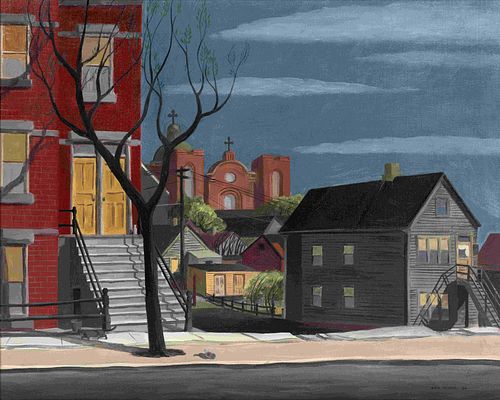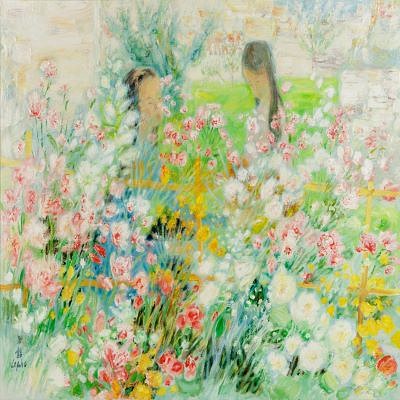Dale Nichols(American, 1904-1995)Chicago, 1934
Lot 4
About Seller
Hindman
1338 West Lake Street
Chicago, IL 60607
United States
Recognized as the Midwest's leading fine art auctioneers, Hindman Auctioneers has built a worldwide reputation based on a full service approach to the auction business tailored to meet the individual needs of our clients. Coming from a variety of educational backgrounds, specialists bring years of e...Read more
Estimate:
$40,000 - $60,000
Absentee vs Live bid
Two ways to bid:
- Leave a max absentee bid and the platform will bid on your behalf up to your maximum bid during the live auction.
- Bid live during the auction and your bids will be submitted real-time to the auctioneer.
Bid Increments
| Price | Bid Increment |
|---|---|
| $0 | $25 |
| $500 | $50 |
| $1,000 | $100 |
| $2,000 | $250 |
| $5,000 | $500 |
| $10,000 | $1,000 |
| $20,000 | $2,500 |
| $50,000 | $5,000 |
| $100,000 | $10,000 |
About Auction
By Hindman
Sep 30, 2020
Set Reminder
2020-09-30 11:00:00
2020-09-30 11:00:00
America/New_York
Bidsquare
Bidsquare : American and European Art
https://www.bidsquare.com/auctions/hindman-auctions/american-and-european-art-5534
Hindman Bidsquare@hindmanauctions.com
Hindman Bidsquare@hindmanauctions.com
- Lot Description
Dale Nichols
(American, 1904-1995)
Chicago, 1934
oil on canvas
signed Dale Nichols and dated (lower right)
24 x 30 ¼ inches.
Provenance:
Mrs. Edwin N. Johnson, Beaumont, Texas, by 1946
Private Collection, Naperville, Illinois
Private Collection, Princeton, New Jersey, acquired directly from the above, 1981
Private Collection, Chicago, acquired directly from the above, 2013
Lot essay:
Chicago, 1934, stands as an early, unique example of Dale Nichols' artwork. According to the Curator of Bone Creek Museum of Agrarian Art, which holds an extensive collection of the artist's work, Chicago is distinctive for its urban setting, as Nichols is best known for his bucolic scenes of countryside red barns (Amanda Mobley Guenther, July 16, 2020). The painting is accompanied by a handwritten letter on Nichols' personalized stationery, from the artist to a Mrs. Edwin N. Johnson. The letter is dated November 24, 1946 and in it Nichols testifies that Chicago is one of the very few paintings he executed 'on the spot.' He was taken to the location by the illustrator Benjamin Stahl (1910-1987), and Nichols goes on to say in the letter that 'The picture does not show the rather tough little boys that crowded about us while we worked.'
Written 14 years after the artwork was painted, the artist cannot recall the exact location of the scene ('on the north side somewhere'). However, Chicago likely depicts an area in the Bucktown neighborhood. Possibly painted on the 1800 block of North Marshfield Avenue, St. Mary of the Angels Roman Catholic Church can be partially viewed from its location at 1850 North Hermitage Avenue. The two houses depicted in the painting still stand, but the view of the church through the stretch of green grass is blocked by two recently built condominiums. The artist would have to have stood facing slightly northwest for the angle and view of the church. Although Nichols simplified the ornate architectural details of the church, the two square towers and the rounded, vertical extension of the center portion of the front facade remain distinct. Both the dome and center portion of the front facade have been remodeled over the years, including brickwork that replaced the rounded extension.
Chicago captures the particular architectural vernacular of the city's neighborhood. Wooden houses like the one on the composition's right were once common in Chicago. These were gradually replaced with dwellings such as the two-flat brick building on the left. The steep, elevated front steps of both homes speak to the Midwest's deep winter snows and the city's residents' ingenuity to squeeze ever more living space in a small footprint. The building structures, with their rectangular blocks of windows and walls, and triangular roofs, reveal Nichols' method of arranging geometric shapes to produce a formal composition. The artist also believed in using a single light source, typically the sun. Strong, dark shadows are cast by the branches of the tree and different elements of both houses.
When transforming his geometric blocks into 'realistic' objects, Nichols tried to paint them abstractly, in a way that expressed their inner reality. Although Chicago is at face value a painting of a city block, the structures and shadows convey a brooding, hard-bitten atmosphere populated by unseen residents. The artist's artistic language is crystallizing into the formal elements for which he was later to become famous. The same year Chicago was produced, Nichols created his most famed painting, End of the Hunt (Metropolitan Museum of Art, New York), which became the basis for all his future works.
Condition
For condition inquiries please contact Mary Grace Bilby at marygracebilby@hindmanauctions.com - Shipping Info
-
Please refer to https://hindmanauctions.com/shipping-packing
-
- Buyer's Premium



 EUR
EUR CAD
CAD AUD
AUD GBP
GBP MXN
MXN HKD
HKD CNY
CNY MYR
MYR SEK
SEK SGD
SGD CHF
CHF THB
THB


















